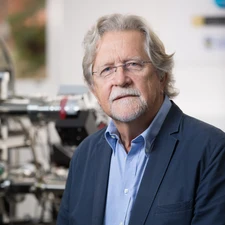Andrew Putnis

The 2018 Robert Wilhelm Bunsen Medal is awarded to Andrew Putnis for outstanding contributions to our understanding of mineral transformations and mineral-fluid interactions.
Andrew Putnis has a highly distinguished research career with many significant advances in our understanding of fluid-rock interactions. One of his most notable discoveries is the concept of mineral replacement reactions, involving the movement of water films directly through mineral grains, leading to the constant volume replacement of one mineral phase with another. This remarkable process, pervasive in the crust, can change the structure and chemical composition of a mineral while preserving its original shape and texture. This discovery provides a far faster way for minerals to transform than what was commonly believed. It can readily explain the rapid transformation of minerals at low temperatures, including such processes as the formation of dolomite and the separation of solid solutions at elevated temperatures. He confirmed the process in many elegant ways, including filming the real-time transformation of sodium chloride to potassium chloride by the passage of water making its own porosity, a film that has inspired many to do further research.
The impact of Putnis’ work is wide-ranging from nanoscale studies of the mineral-fluid interface to the large-scale consequences of metasomatism, metamorphism and rock deformation. He has been a major force in applying in situ atomic force microscopy to study factors that control the mechanisms of mineral dissolution and precipitation. This is crucial for understanding processes that take place at the mineral-fluid interface, with wide-ranging applications including the development of strategies to clean up environmental waste, prediction of the durability of nuclear waste glass, the chemical sequestration of carbon dioxide, and prevention of mineral scaling in industrial processes.
